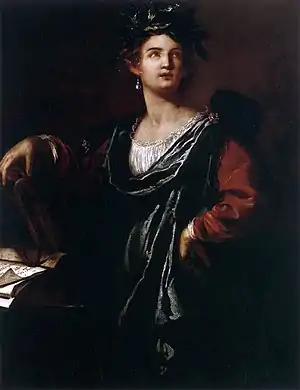Clio, Muse of History (Pisa)
Clio, Muse of History is a painting by the baroque painter Artemisia Gentileschi. It was painted around 1632, just after Artemisia had moved to Naples. It currently hangs in the Palazzo Blu, Pisa.[1] The painting has been interpreted in relationship to Gentileschi's own career and self-image - "by including her signature in Clio's open book, Artemisia was quite literally writing herself into history".[2][3] In stylistic terms, the painting demonstrates Gentileschi's borrowing from Venetian styles of painting where she "applied her colors in a free and more spontaneous fashion."[4]
| Clio, Muse of History | |
|---|---|
| Clio | |
 | |
| Artist | Artemisia Gentileschi |
| Year | 1632 |
| Medium | oil paint, canvas |
| Dimensions | 127.6 cm (50.2 in) × 97.5 cm (38.4 in) |
| Location | Palazzo Blu |
Description
A woman is shown in three-quarter view, turned to her right looking over her left shoulder, eyes cast upwards. Her left hand rests on her hip, with her right hand resting on a trumpet perched on an open book. She wears a crown of leaves as well as a large pearl earring in her right ear. She wears a russet-coloured gown over a white chemise, covered with a blue mantle pinned with a brooch at the left shoulder. The space in which she stands is dark, with a light source from the left casting highlights on her face, chemise and the pages of the book.
The figure depicted is Clio, the Muse of History. Cesere Ripa's Iconologia, an important source book for artists of the time, stated that Clio should be depicted with a crown of laurels, a trumpet and an open book.[5] Traces of earlier painting underneath the surface suggest, but cannot definitively prove, that the earlier subject was that of Fame, another figure from Ripa's Iconologia. It was not uncommon for Gentileschi to reuse or alter course during the painting of a canvas.[2]
History
On the book on the left of the painting the date 1632 is inscribed, along with Artemisia's name (which is written in upper case) The name of "F. Rosier" is also recorded in the inscription. This is likely to be François de Rosières, a French nobleman and academic who had been in the service of the Duke of Guise, who, after a rift with Cardinal Richelieu, had fled his home country and was living in Italy at the time.[2] In a 1635 letter to Galileo Galilei, the artist mentions receiving payment for a work delivered to the Duke.[6]
Provenance
The work was most likely painted for Charles of Lorraine, 4th Duke of Guise.[7] Nothing is known of its whereabouts until it appeared at a London gallery in 1940.[7] It moved through several collections in Great Britain and New York before its sale in December 2004 to the present owners.[7]
References
- "Clio, la musa della storia, olio su tela". Palazzo Blu (in Italian). Retrieved 2021-04-08.
- Whitlum-Cooper, Francesca (2020). Treves, Letizia (ed.). Artemisia. London: The National Gallery Company Ltd. p. 200. ISBN 978-1-85709-656-9. OCLC 1117638110.
- Garrard, Mary D. (2020). Artemisia Gentileschi and feminism in early modern Europe. London, UK. pp. 215–7. ISBN 978-1-78914-239-6. OCLC 1147832296.
{{cite book}}: CS1 maint: location missing publisher (link) - Locker, Jesse (2015). Artemisia Gentileschi : the language of painting. New Haven. p. 117. ISBN 978-0-300-18511-9. OCLC 877369691.
{{cite book}}: CS1 maint: location missing publisher (link) - Ripa, Cesare (1611). Iconologia (in Italian).
- Gentileschi, Artemisia, or 1653 (2011). Solinas, Francesco (ed.). Lettere di Artemisia : edizione critica e annotata con quarantatre documenti inediti (in Italian). Roma: De Luca. pp. 109–110. ISBN 9788865570524.
{{cite book}}: CS1 maint: multiple names: authors list (link) - "Immunity From Seizure: Artemisia" (PDF). The National Gallery, London.